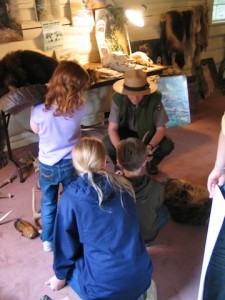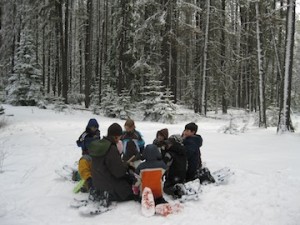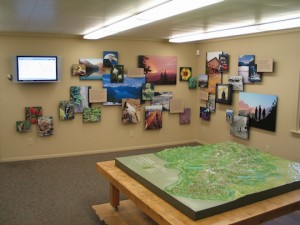Entrances at West Glacier and St. Mary’s
Lesson Cornerstone:
Ecosystems; watersheds; habitats; fire and winter ecology; earth science
Curriculum Content Standards: Science
(1) Students, through the inquiry process, demonstrate the ability to design, conduct, evaluate, and  communicate the results and form reasonable conclusions of scientific investigations.
communicate the results and form reasonable conclusions of scientific investigations.
(2) Students, through the inquiry process, demonstrate knowledge of properties, forms, changes and interactions of physical and chemical systems.
(3) Students, through the inquiry process, demonstrate knowledge of characteristics, structures and function of living things, the process and diversity of life, and how living organisms interact with each other and their environment.
(4) Students, through the inquiry process, demonstrate knowledge of the composition, structures, processes and interactions of Earth’s systems and other objects in space.
(5) Students, through the inquiry process, understand how scientific knowledge and technological developments impact communities, cultures and societies.
Site Description:
Glacier National Park is the center of the Crown of the Continent Ecosystem and is over a million acres in size. It became our nation’s tenth national park in 1910. The park has evidence of thousands of years of human presence. It is named for the prominent glacier-carved terrain. During the school year, the central Going-to-the-Sun Road, which runs east to west through the park and over the Continental Divide, is not plowed of snow. Many of the alpine sections of the park are difficult to access in the winter. Education groups can find many opportunities to visit the lower valleys of the park at St. Mary’s (east of the divide) and West Glacier (west of the divide).
Trails and Terrain:
There are over 700 miles of trail that vary in length from one mile to multi-day hikes. Information about trails and their status can be found here. All trails are signed. However, during the winter when the Going-to-the-Sun Road is not plowed, trail access is by snowshoe or skis and all visitors must be self-sufficient. The terrain also varies from flat to very steep.
Wildlife Present:
Glacier is home to nearly 70 species of mammals, including the grizzly bear, wolverine, gray wolf and lynx.  Over 270 species of birds visit or reside in the park, including such varied species as harlequin ducks, dippers and golden eagles. This is grizzly and mountain lion country.
Over 270 species of birds visit or reside in the park, including such varied species as harlequin ducks, dippers and golden eagles. This is grizzly and mountain lion country.
On-Site Educational Programs:
Ranger-led, curriculum-based educational programs are available, Monday through Friday from September to October, January to March and in May. Descriptions and objectives for the educational programs may be viewed on the website and can discussed with the Glacier Education Specialist. There is also information about bringing a group on your own, obtaining fee waivers and safety considerations.
Seasons:
Ranger-led programs are available from September to October, January to March and in May.
Access:
There is a vehicle size limit for some stretches of the Going-to-the-Sun Road due to its narrow and winding nature. School buses are restricted to lower elevations. Education groups may plan their visits in the summer, using the park shuttle system. At various times during the school year, buses can access: Apgar Visitor Center; Fish Creak Picnic Area; Avalanche Picnic Area; St. Mary’s Visitor Center; the 1913 Ranger Station Parking Area and trails; and Rising Sun Parking Area. Winter conditions limit access to Apgar and St. Mary’s. Road conditions are updated here.
A full description of ADA accessibility can be found here.
Parking and Entrance to Site:
To travel to Apgar, take Montana Highway 2 to West Glacier, turn north and proceed to the park entrance  station. Apgar Village is through the entrance station, then left at the “T” intersection, and take the second right. The visitor center is just down the road on the left before reaching Lake McDonald. There is a parking area at Apgar.
station. Apgar Village is through the entrance station, then left at the “T” intersection, and take the second right. The visitor center is just down the road on the left before reaching Lake McDonald. There is a parking area at Apgar.
To travel to St. Mary’s from the Flathead Valley, take Montana Highway 2 east and turn left on Montana Highway 49 north. Take Montana Highway 89 and turn west into the park at St. Mary’s. The 1913 Ranger station is over the bridge and the first left, then right. The road ends in the parking area. There is a trail from the parking area up to the cabin.
Google Earth Driving Directions:
Group size limits:
Ranger-led programs have group size limits. Please contact the education specialist for more information.
Fees:
Park entrance fee. An educational fee waiver may be requested in advance.
Other Suggestions:
Dress appropriately for sudden changes in winter weather. Bring bear spray.
Site services:
Restrooms are limited.
Contact Information:
Education Specialist, Glacier National Park, 888-5837